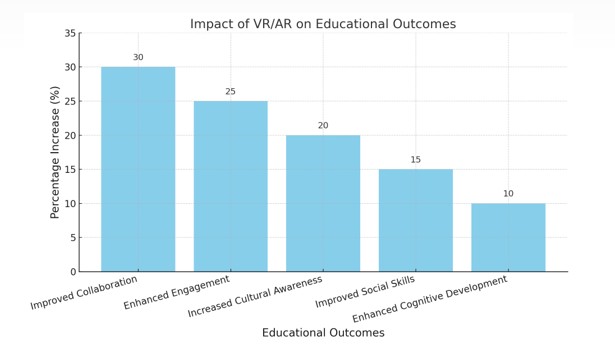Contextual Learning in the Digital Age: Designing Virtual and Augmented Reality Environments Based on Situated Cognition
คำสำคัญ:
contextual learning, situated cognition, virtual reality, augmented reality, immersive educationบทคัดย่อ
In the digital era, educational paradigms are increasingly shaped by immersive technologies such as virtual reality (VR) and augmented reality (AR), which offer transformative potential for contextual learning. Grounded in the theory of situated cognition, this paper explores how learning environments can be designed to reflect real-world situations, thereby promoting deeper engagement and knowledge retention. The research highlights the theoretical underpinnings of situated cognition, emphasizing that learning is most effective when it occurs in authentic, socially interactive settings. It examines the integration of VR and AR as tools for simulating these contexts, drawing on case studies such as the AR-CIMUVE project and virtual field trips that facilitate embodied learning experiences. Furthermore, the paper identifies key benefits—such as increased motivation, improved collaboration, and enhanced cultural awareness—while also addressing challenges, including technical barriers, health concerns, and pedagogical misalignment. By reviewing current applications in both educational and public health contexts, the study underscores the importance of designing immersive environments that are ethically sound, pedagogically effective, and technologically feasible. This synthesis informs a framework for future innovations in educational technology, suggesting that effective implementation of AR/VR requires not only technical infrastructure but also a deep understanding of how context and interaction shape learning. The paper concludes with reflections on the evolving role of educators and the imperative to address digital divides to ensure equitable access to immersive learning experiences.
เอกสารอ้างอิง
Abrahamson, D., & Lindgren, R. (2014). Embodiment and embodied design. https://core.ac.uk/download/305123886.pdf
Adams, A., Ferguson, R., FitzGerald, E., Gaved, M., et al. (2012). Augmented reality and mobile learning: The state of the art. https://core.ac.uk/download/82974516.pdf
Agostini, D., & Petrucco, C. (2016). Teaching cultural heritage using mobile augmented reality. https://core.ac.uk/download/80155599.pdf
Amin, A., Clark, A., Spagnolli, A., Latour, B., et al. (2015). An action-based approach to presence: Foundations and methods. https://core.ac.uk/download/53520414.pdf
Behringer, R., & Sinclair, G. (2013). Proceedings of the International Workshop on EuroPLOT Persuasive Technology for Learning, Education and Teaching (IWEPLET 2013). https://core.ac.uk/download/29018755.pdf
Bidding Evaluation and Contractor Selection Using Balance Index Model and Comprehensive Input Efficiency Based on Data Envelopment Analysis. (2025). Systems, 11(5), Article 244. https://www.mdpi.com/2079-8954/11/5/244
Biggest educational technology trends of 2024. (2024). SMU Online Learning Sciences Blog. https://learningsciences.smu.edu/blog/biggest-educational-technology-trends-of-2024
Börner, D., De Vries, F., Drachsler, H., Kalz, M., et al. (2012). RTST Trend Report: Lead theme contextualisation. https://core.ac.uk/download/521358845.pdf
Bowen, M. (2018). Effect of virtual reality on motivation and achievement of middle-school students. https://core.ac.uk/download/480755151.pdf
Brown, E. (2010). Introduction to location-based mobile learning. https://core.ac.uk/download/109263.pdf
Brown, E., Börner, D., de Jong, T., Glahn, C., et al. (2010). Location-based and contextual mobile learning: A STELLAR small-scale study. https://core.ac.uk/download/109571.pdf
Brown, E., Polmear, G., Priestnall, G., Sharples, M., et al. (2010). Augmenting the field experience: A student-led comparison of techniques and technologies. https://core.ac.uk/download/106722.pdf
Burden, K. J. (2010). Conceptualising teachers' professional learning with Web 2.0. https://core.ac.uk/download/151161506.pdf
Burleigh, C., Steele, P. B., & Young, E. A. (2020). Considering educators’ perceptions of ethics and safety in virtual learning environments (VLEs). https://core.ac.uk/download/368410304.pdf
Cheung, S. K. S., Kwok, L. F., Phusavat, K., & Yang, H. H. (2021). Shaping the future learning environments with smart elements: Challenges and opportunities. International Journal of Educational Technology in Higher Education, 18(16). https://educationaltechnologyjournal.springeropen.com/articles/10.1186/s41239-021-00254-1
Chylinski, M., de Ruyter, K., Heller, J., Hilken, T., et al. (2018). Making omnichannel an augmented reality: The current and future state of the art. https://core.ac.uk/download/157854399.pdf
Frydenberg, S. (2024). Cultivating serendipity in design complexity: Exploring designs of augmented reality technologies for ship bridges. https://core.ac.uk/download/630799803.pdf
Godwin-Jones, R. (2023). Emerging spaces for language learning: AI bots, ambient intelligence, and the metaverse. https://core.ac.uk/download/555180056.pdf
Godwin-Jones, R. (2023). Presence and agency in real and virtual spaces: The promise of extended reality for language learning. https://core.ac.uk/download/590218014.pdf
Han, H. (2019). Connecting levels of analysis in educational neuroscience: A review of multi-level structure of educational neuroscience with concrete examples. https://core.ac.uk/download/223236302.pdf
Hanheide, M. (2006). A cognitive ego-vision system for interactive assistance. https://core.ac.uk/download/9553727.pdf
Hsu, K. C., & Liu, G. Z. (2024). Towards a design of the best practices for AR‐guided oral communication development: A systematic review of selected research published from 2000 to 2023. Journal of Computer Assisted Learning. https://www.semanticscholar.org/paper/728816a46e0854091620f6ba9cc52765ceb40c87
Sahinler Albayrak, M. (2022). Exploring English as an additional language students’ perceived engagement in and experience of content vocabulary acquisition and retention through immersive virtual reality games. https://core.ac.uk/download/565911820.pdf
Shaer, O., & Hornecker, E. (2009). Tangible user interfaces: Past, present and future directions. https://core.ac.uk/download/9033674.pdf
Walsh, B. (2021). The metaverse medical student. Axios. https://www.axios.com/2021/12/08/extended-reality-virtual-medical-education
Lee, Y. C. J., & Takenaka, B. P. (2022). Extended reality as a means to enhance public health education. Frontiers in Public Health, 10. https://pubmed.ncbi.nlm.nih.gov/36504953/
Makransky, G., & Mayer, R. E. (2022). Benefits of taking a virtual field trip in immersive virtual reality: Evidence for the immersion principle in multimedia learning. Educational Psychologist Review, 34(3), 1771–1798. https://pubmed.ncbi.nlm.nih.gov/35475019/
Payne, J. (2024). USU researcher awarded $2M grant to create virtual reality teacher trainings on behavior intervention. Utah State University. https://www.usu.edu/today/story/usu-researcher-awarded-2m-grant-to-create-virtual-reality-teacher-trainings-on-behavior-intervention
Espinoza, J. (2025). Teaching award: Rising to the challenge. Financial Times. https://www.ft.com/content/bad75b74-a260-4306-8b9f-9281bc0ca85a
Lowell, V. (2024). Extended reality (XR) for authentic learning: New frontiers in educational technology. The Journal of Applied Instructional Design. https://www.semanticscholar.org/paper/2b72b38cc8e563520247c24a7bd35a301a09ba4f

ดาวน์โหลด
เผยแพร่แล้ว
รูปแบบการอ้างอิง
สัญญาอนุญาต
ลิขสิทธิ์ (c) 2025 วารสารวิชาการสังคมศาสตร์สมัยใหม่ (Online)

อนุญาตภายใต้เงื่อนไข Creative Commons Attribution-NonCommercial-NoDerivatives 4.0 International License.





